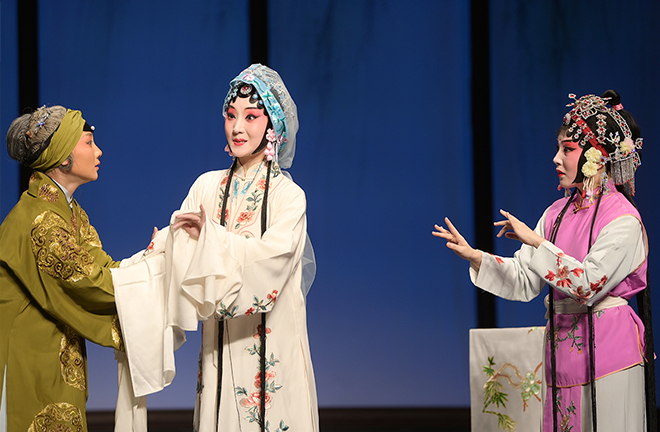Digitization carries forward traditional opera

“The Peony Pavilion” staged at the Kunshan Modern Kunqu Opera Theater in Kunshan, Jiangsu Province, Jan. 7 Photo: CFP
Chinese opera is the quintessence of traditional Chinese culture and a valuable intangible cultural heritage. As the rapid development of the internet and digital technology leads to expanding digitization coverage of various documents, digitization of traditional Chinese opera is necessary to realize its protection, inheritance, performance viewing, and dissemination.
Necessary pathway
The digitization of traditional opera falls into two spheres: digitization of ancient opera literature, and visual-audio digitization of opera performances. In recent years, China has stepped up efforts in digitization of traditional opera, saved endangered local operas and classic plays from extinction, and refreshed traditional opera with new vigor.
The digitization of documents about ancient opera compiles and protects related literature, making it more convenient and efficient for researchers of ancient literature and ancient opera to refer to them, said Li Mei, a research fellow from the Institute of Literature at the Chinese Academy of Social Sciences.
Zhao Xiaohong, a professor from the Shanghai Film Academy at Shanghai University, noticed that traditional opera has the potential and space to take advantage of digitization in inheritance, creation, rehearsal, and other links, due to both internal and external driving forces. The inner cause is determined by the essence of opera. In nature, opera is an entertainment and cultural consumption activity, whose development is closely related to the needs of audiences. With fast-growing digital technology such as digital imaging and virtual reality, people’s cultural consumption tends to be networked, mobile, and digital. For opera, it is natural to meet the needs of audiences with the aid of digitization. The external cause benefits from national emphasis on the inheritance and development of traditional culture in the new era, which strengthens the protection of intangible cultural heritage.
Challenges
Prompted by industrialization and digital technology, each stage of operatic art has been presented in various media forms, from albums, videos, films, and television, to the internet and multimedia. Yet, it has inevitably encountered difficulties in the digitization process.
The fundamental state of any drama, including the operatic arts, contains the two elements of actors and audiences, said Xie Boliang, a professor from the School of Humanities at Shanghai Jiao Tong University. A performance without an audience can only be a rehearsal. However, in the shooting process of opera films and TV dramas, there is no response from the audience or applause, which is a relatively silent state of self-performance. Obviously not being the best performance atmosphere, it is also not conducive to inspiring the best performance of artists, and goes against the normality of creation and aesthetics of the opera performance’s actors and audiences.
At the same time, when film aesthetics is combined with opera aesthetics, a conflict between the “virtual” and “real” is generated, Xie added. The performance of opera is a virtual, free, and highly expressive process. Amid libretto rules and performance patterns, characters can smoothly switch to another time and space. The aesthetics of opera performances has thus become a simple and elegant presentation of “taking the virtual as a means and fusing the virtual and real.” However, filming movies and TV plays often needs real props, scenes, and atmospheres, causing incompatible conflicts between the virtual realm of performances and the reality of the scene.
Although technology can empower art, without the support of a sustainable talent pool, artistic development will be a restraint, Zhao said. Digital media technology can record the original state of operas, opera performance activities, and the interaction between the audience and opera creators, thereby maximizing the preservation of exquisite opera art and facilitating the inheritance of opera. When enhancing the spread of traditional opera, it possibly “subverts” traditional opera in both forms and content, and creates a new “digital opera.” Yet, opera digitalization requires interdisciplinary talent with operatic art and computer knowledge, and there is no clear talent training program in higher education institutions at present.
Intensive development
The digitization of traditional Chinese opera has gone through more than 30 years. In the most recent decade, the country has invested considerable efforts into opera digitization, witnessing a shift of focus from the digitization of opera books and scripts in the early stage to an audio and video digitization.
According to Li Zhiyuan, a research fellow from the Opera Institute at the Chinese National Academy of Arts, digital media technology is able to improve the dissemination speed and scope of operas and retain stage moments, while, in stage creation, enriching the vocabulary of stage presence and shortening the distance between traditional and trendy. Digital media technology has also brought great guarantee and convenience to opera education and research. Despite this, the digitization of traditional operas is still in an extensive stage, and an all-round intensive digitization of an entire genre of operas is still pending.
Li Zhiyuan noted that the current task is to convert opera digitization from extensive to intensive development. In terms of a single genre of opera, from the dual perspective of popularization and research, its digital resource library should encompass the introduction of the history of the genre, performance features, and inheritor echelons, as well as such original works as scripts, musical scores, audio and video data, and research works. In addition, it should offer an explanation of costume, makeup, wenchang [string and wind instruments in Chinese operas] and wuchang [percussion instruments in Chinese operas], the creation and choreography concept of representative works, appreciation essentials, and aesthetic pursuits. On the premise of maintaining the core artistic attributes of the genre, the focus is on the wielding of digital technology to enhance the appreciation of stage creation.
